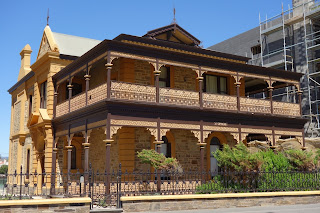Knowing that today was my last day in Adelaide (at least for now anyway - I may end up back here again at some point), I tried to make the most of the day.
First off I went to the Adelaide Central Market and wandered around it for a while. The Market began in 1869 and was known as the City Markets, with its official opening in January 1870. Reflecting the heritage and character of the market is the building facade still in place today, dating from 1900. Today Adelaide Central Market is a large multicultural market in the centre of the CBD. It sells a wide variety of goods including food, toys, jewelry, rugs, seafood, gourmet items, groceries and much, much, more. It has a vibrant atmosphere and is one of Adelaide's best known landmarks.
The Central Market leads right into Adelaide's Chinatown. Two large Paifang, guarded by the Chinese guardian lions mark the entrance to Chinatown.
This afternoon I decided to take advantage of the great weather and do something outdoors so I went out to Glenelg, a very popular beach-side suburb in Adelaide. Established in 1836, it is the oldest European settlement on mainland South Australia (the oldest being on Kangaroo Island). It was named after Lord Glenelg, a member of the British Cabinet and Secretary of State for War and the Colonies.
Through Lord Glenelg the name derives from Glenelg, Highland (previously Inverness-shire), Scotland. In Scottish Gaelic the name is Gleann Eilg. The name Glenelg is noteworthy for being a palindrome.
The Town Hall was built in 1875 as the Institute building. The Glenelg Council acquired it in 1887 when it became the Town Hall.
In 1857, construction of Glenelg's first jetty commenced and it was opened in 1859. Costing over £31,000 to build, the structure was 381 metres long. Over the years there were several additions to the jetty. A lighthouse was built in 1872 at the jetty's end, but a year later it caught fire and was cast into the sea to save the rest of the structure. A replacement lighthouse was built in 1874, and was 12.1 metres tall. Other additions included public baths, an aquarium, a police shed and a three-story kiosk with tea rooms. The kiosk structure also housed a family. The kiosk was wrecked in a storm in 1943, and the entire jetty was destroyed by a freak cyclone in 1948, most of the structure washed away and the rest unsafe. Just two weeks later, the local council began drafting plans for a new jetty and construction was completed in 1969. The new structure was just 215 metres long, less than two-thirds of the original jetty. The second jetty is what still stands today.
This is Glenelg Beach, looking north
and looking south. Definitely a nice place to spend these summer days!
The Pioneer Memorial which you can see in the middle of this photo was erected as a state centenary project in 1936.
Take a walk along the esplanade at Glenelg and it's pretty easy to see the money that was once in place here. This building, Stormont, was built in 1886 and is now a family home.
Glenara is one of Glenelg's stately treasures. It was built in 1873 for William Hill and was still owned by Hill's descendants until 1990. Now it is privately owned and is also a family home.
The marinas at Glenelg are a good indication of the money that still remains in Glenelg today.
In the background of this photo you can see a replica of the HMS Buffalo which was the ship that, in 1836, brought the first governor from England to what became South Australia.
Back into the city centre and I thought that a good way to end my time in Adelaide would be to go to what is known as "Light's Vision". The first surveyor-general of Adelaide, Colonel William Light, designed a layout and development programme for the city. This plan is now known as "Light's Vision". Notable aspects of Light's plan are that the city centre is laid out in a grid-like pattern, with squares in the centre of the city and in the centres of the four quarters of the city, and the city is surrounded by parklands.
Legend has it that William Light stood on Montefiore Hill (in North Adelaide) in 1837, pointed at what would one day become the Adelaide city centre, and began planning the city. This moment is commemorated by a statue on Montefiore Hill, pointing at the City of Adelaide below.
Having showed off a few of the beautiful, old, historic buildings in North Adelaide I thought you might like to see the 'motel' I'm staying in - the Princes Lodge Motel. It was built in 1913 as a private residence.
Just a little apology at this time for the little black spot that you see in many of my photos now. Unfortunately a little bit of dust has gotten inside the camera and is on the sensor, and it's not something I can clean or fix by myself. When I'm in Perth for the next little while I'll take it into a store there and see if it can be cleaned... hopefully without me having to be without my camera for long 😕














No comments:
Post a Comment